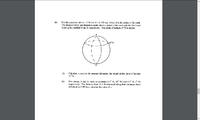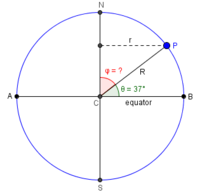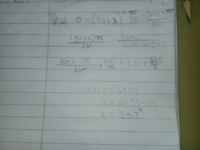You are using an out of date browser. It may not display this or other websites correctly.
You should upgrade or use an alternative browser.
You should upgrade or use an alternative browser.
J: I'm in a pickle :L
- Thread starter Denzel
- Start date
Dr.Peterson
Elite Member
- Joined
- Nov 12, 2017
- Messages
- 16,086
Another hint: the latitude 37 degrees is the angle from the equator to the circle. What is the angle from the north pole? Add in to the diagram the line joining the north pole to the center, and the radius to a point on the circle. Then think about how to find the radius of the circle itself.
37 degrees from the north pole? Sorry. I don't understand what you mean. :/Another hint: the latitude 37 degrees is the angle from the equator to the circle. What is the angle from the north pole? Add in to the diagram the line joining the north pole to the center, and the radius to a point on the circle. Then think about how to find the radius of the circle itself.
Dr.Peterson
Elite Member
- Joined
- Nov 12, 2017
- Messages
- 16,086
What is your understanding of what latitude means?
Okay, so from what I understand, latitude it is length ways from the equator. And is measured from 0° - 90°.What is your understanding of what latitude means?
Dr.Peterson
Elite Member
- Joined
- Nov 12, 2017
- Messages
- 16,086
Otis
Elite Member
- Joined
- Apr 22, 2015
- Messages
- 4,414
Latitude is an angle. (Maybe you were thinking 'arclength'.)… latitude it is length …
?
- Joined
- Nov 24, 2012
- Messages
- 3,021
Okay, so, what I did was find the circumference of the earth 2πr and the multiply it by cos 37°. This was question 1 ( And I still don't fully understand it though.. :l )
That will work, but what I was asking you to do is use the definition of the cosine function on the right triangle in my diagram to state:
[MATH]\cos(\theta)=\frac{a}{r_E}\implies a=r_E\cos(\theta)[/MATH]
And so the length or circumference \(C\) of the circle is:
[MATH]C=2\pi a=2\pi r_E\cos(\theta)[/MATH]
This is what you did, but it shows why it works.
I see.That will work, but what I was asking you to do is use the definition of the cosine function on the right triangle in my diagram to state:
[MATH]\cos(\theta)=\frac{a}{r_E}\implies a=r_E\cos(\theta)[/MATH]
And so the length or circumference \(C\) of the circle is:
[MATH]C=2\pi a=2\pi r_E\cos(\theta)[/MATH]
This is what you did, but it shows why it works.
- Joined
- Nov 24, 2012
- Messages
- 3,021
For question (ii), we could use the arc-length formula:
[MATH]s=r\theta\implies \theta=\frac{s}{r}[/MATH]
We are given \(s\), and \(r=r_E\cos\left(37^{\circ}\right)\). We need to express \(\theta\) as a function of \(x\), by computing the difference in the given longitudes, and this angular difference needs to be in radians. Can you proceed?
[MATH]s=r\theta\implies \theta=\frac{s}{r}[/MATH]
We are given \(s\), and \(r=r_E\cos\left(37^{\circ}\right)\). We need to express \(\theta\) as a function of \(x\), by computing the difference in the given longitudes, and this angular difference needs to be in radians. Can you proceed?
- Joined
- Nov 24, 2012
- Messages
- 3,021
We have one location that is \(50^{\circ}\) west of the prime meridian, and another that is \(x^{\circ}\) east of the prime meridian, hence:
[MATH]\theta=(50+x)^{\circ}\frac{\pi}{180^{\circ}}=\frac{(50+x)\pi}{180}[/MATH]
Thus we want:
[MATH]\frac{(50+x)\pi}{180}=\frac{5390}{6370\cos\left(37^{\circ}\right)}[/MATH]
Can you solve for \(x\)?
[MATH]\theta=(50+x)^{\circ}\frac{\pi}{180^{\circ}}=\frac{(50+x)\pi}{180}[/MATH]
Thus we want:
[MATH]\frac{(50+x)\pi}{180}=\frac{5390}{6370\cos\left(37^{\circ}\right)}[/MATH]
Can you solve for \(x\)?




